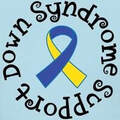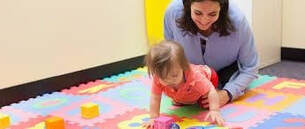- Home
-
Resources
-
Exercise & Activities
>
-
Strength
>
- Full Body - Motor Planning & Gross Motor Activities
- Full Body - Kicking
- Full-Body Crab Walking
- Full Body - Laundry Basket Push/Pull
- Legs - Lower Extremity Strengthening Activities
- Legs - Step ups onto a stool
- Legs - Squatting
- Arms
- Core - Core Stability & Upper Extremity Strengthening Activities
- Core - Core exercise on pillow
- Core - Four Point
- Core - Using Bubbles for Core Strength
- Coordination >
- Balance >
- Stairs >
-
Strength
>
- Sensory Motor >
- Stretches & Flexibility >
- Caregivers Tips >
- Equipment Use >
- By Diagnosis >
- Outdoor Activities
-
Exercise & Activities
>
- Contact
- Bulletin Board
What is Down Syndrome?
Down Syndrome is a lifelong condition that occurs when a person has an extra set of chromosomes. Chromosomes are small units of genetic material that determine a person’s makeup. Someone with Down Syndrome usually has a partial or full extra copy of chromosome #21. Down Syndrome is the most common chromosomal condition, and it occurs in about 1 out of every 700 births in the US, and there are an estimated 6,000 babies born with Down Syndrome in the US each year.
Down Syndrome is a lifelong condition that occurs when a person has an extra set of chromosomes. Chromosomes are small units of genetic material that determine a person’s makeup. Someone with Down Syndrome usually has a partial or full extra copy of chromosome #21. Down Syndrome is the most common chromosomal condition, and it occurs in about 1 out of every 700 births in the US, and there are an estimated 6,000 babies born with Down Syndrome in the US each year.
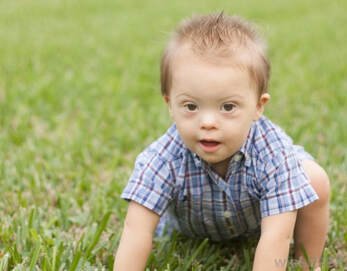
What should I look for if my child has Down Syndrome?
Each child is different and no case is the same, however, common physical traits of children diagnosed with Down Syndrome are:
Each child is different and no case is the same, however, common physical traits of children diagnosed with Down Syndrome are:
- A flattened face, especially the bridge of the nose
- Almond-shaped eyes that slant up
- A short neck
- Small ears
- A tongue that tends to stick out of the mouth
- Tiny white spots on the iris (colored part) of the eye
- Small hands and feet
- A single line across the palm of the hand (palmar crease)
- Small pinky fingers that sometimes curve toward the thumb
- Poor muscle tone or loose joints
- Shorter in height as children and adults
What else should I be aware of if my child is diagnosed with Down Syndrome?
Once again, each individual is different so this condition will vary. Some Individuals with Down Syndrome may also have associated health complications such as:
Down Syndrome can also affect an individual’s cognitive ability. This can affect their ability to think, reason, understand, communicate, and be social. However many individuals with Down Syndrome live fulfilling lives in which they have jobs, relationships, and can perform most activities of daily living independently.
What are terms my doctor might use when discussing Down Syndrome?
Some terms to be aware of when discussing Down Syndrome with your Doctor are:
Once again, each individual is different so this condition will vary. Some Individuals with Down Syndrome may also have associated health complications such as:
- H earing loss
- Obstructive sleep apnea
- Ear infections
- Eye diseases
- Heart Defects present at birth
Down Syndrome can also affect an individual’s cognitive ability. This can affect their ability to think, reason, understand, communicate, and be social. However many individuals with Down Syndrome live fulfilling lives in which they have jobs, relationships, and can perform most activities of daily living independently.
What are terms my doctor might use when discussing Down Syndrome?
Some terms to be aware of when discussing Down Syndrome with your Doctor are:
- Chromosome - A chromosome is a small package of genetic material (DNA) that is located in each cell of your body. Typically each person has 23 pairs of chromosomes, equaling 46 total chromosomes. Someone with Down Syndrome will have an extra copy of one of these small chromosomes.
- Trisomy 21 - This is another name for Down Syndrome. It refers to the fact that the child has an additional #21 chromosomes, meaning that they have 3 of these chromosomes as opposed to the traditional 2.
- Low Tone - You may hear your Dr. use the phrase “low tone” when referencing possible conditions associated with Down Syndrome. This means that the child may have floppy muscles and joints. The degree of laxity will differ from child to child, however, this is something that can be addressed with physical therapy.
|
How can Physical Therapy help my child?
Down Syndrome is a lifelong condition, however there are ways in which you as a parent can help your child be successful! Early interventions through physical therapy can be key to helping your child become stronger and more independent. Physical therapy can help your child develop strength, coordination, balance, and many other skills necessary to perform functional tasks. Your physical therapist will create an individualized plan to help your child reach their goals throughout their different stages of development. |
What activities can I do with my child at home?
Talk to your physical therapist about different activities that you can do with your child to help them achieve their goals. Many therapists will give you a specialized home exercise program to perform with your child focused on improving their physical abilities. It may include activities such as:
Talk to your physical therapist about different activities that you can do with your child to help them achieve their goals. Many therapists will give you a specialized home exercise program to perform with your child focused on improving their physical abilities. It may include activities such as:
- Standing: Have your child practice standing up by placing a toy at their feet and having them place it on some type of elevated surface that they have to reach for such as a couch or a stable chair. As long as the object is stable the child can hold on to the object if necessary, and eventually progress to standing without the need to hold on to something.
- Walking: If your child is having trouble walking, have them start by pushing an object around the house such as a laundry basket or a larger toy. They can hold on to the object as they walk which will provide more stability for them as they work on walking.
- Strength: You can do so many strength activities from the comfort of your own home with your child! Have your child push and pull slightly heavy objects such as a laundry basket with toys in it or a large stuffed animal. Make it a game by having them push/pull the object through a homemade obstacle course, or just by sitting on the floor and pushing/pulling the object between the two of you.
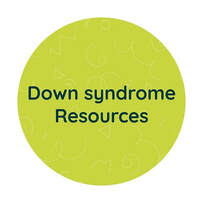
Support Groups and Resources:
- Michigan Alliance for Families:
- Michigan Down Syndrome Support Organizations
- Down Syndrome Guild of Southeast Michigan
- National and Michigan Resources and Groups
- Down Syndrome Support Group in Southeast Michigan
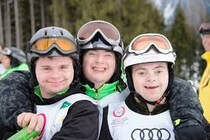
Local Activity Groups
Inclusive Camps in Michigan
Information References:
https://www.cdc.gov/ncbddd/birthdefects/downsyndrome.html
https://www.ndss.org/about-down-syndrome/down-syndrome/
https://www.mayoclinic.org/diseases-conditions/down-syndrome/symptoms-causes/syc-20355977
https://www.choosept.com/symptomsconditionsdetail/physical-therapy-guide-to-down-syndrome-2
- Down Syndrome Support Group - Classes & Activities
- Area 13 Special Olympics - Flint, MI
Inclusive Camps in Michigan
- Camp Skyline and Retreat Center (Almont, MI)
- Indian Trails Summer Camp and Weekend Respites (Grand Rapids, MI)
- List of all Special Need Friendly Camps in Michigan
Information References:
https://www.cdc.gov/ncbddd/birthdefects/downsyndrome.html
https://www.ndss.org/about-down-syndrome/down-syndrome/
https://www.mayoclinic.org/diseases-conditions/down-syndrome/symptoms-causes/syc-20355977
https://www.choosept.com/symptomsconditionsdetail/physical-therapy-guide-to-down-syndrome-2
| Down Syndrome Information_.pdf | |
| File Size: | 695 kb |
| File Type: | |
- Home
-
Resources
-
Exercise & Activities
>
-
Strength
>
- Full Body - Motor Planning & Gross Motor Activities
- Full Body - Kicking
- Full-Body Crab Walking
- Full Body - Laundry Basket Push/Pull
- Legs - Lower Extremity Strengthening Activities
- Legs - Step ups onto a stool
- Legs - Squatting
- Arms
- Core - Core Stability & Upper Extremity Strengthening Activities
- Core - Core exercise on pillow
- Core - Four Point
- Core - Using Bubbles for Core Strength
- Coordination >
- Balance >
- Stairs >
-
Strength
>
- Sensory Motor >
- Stretches & Flexibility >
- Caregivers Tips >
- Equipment Use >
- By Diagnosis >
- Outdoor Activities
-
Exercise & Activities
>
- Contact
- Bulletin Board
